
Swainsona behriana, commonly known as Behr's swainsona, is a species of flowering plant in the family Fabaceae and is endemic to south-eastern continental Australia. It is a prostrate or low-growing perennial herb with imparipinnate leaves usually with 9 to 13 narrowly elliptic to egg-shaped leaflets with the narrower end towards the base, and racemes of 2 to 7 purple flowers.

Vesselowskya rubifolia, commonly known as southern marara, red ash, mountain marara or Dorrigo southern marara, is a species of flowering plant in the family Cunoniaceae plant and has a restricted distribution in eastern New South Wales. It is a shrub or small tree with compound leaves with three or five leaflets with serrated edges, and small whitish flowers arranged along a raceme.

Austrocallerya megasperma, one of several species commonly known as native wisteria, is a species of flowering plant in the family Fabaceae and is endemic to eastern Australia. It is a woody climber with pinnate leaves and racemes of purple, pea-like flowers.
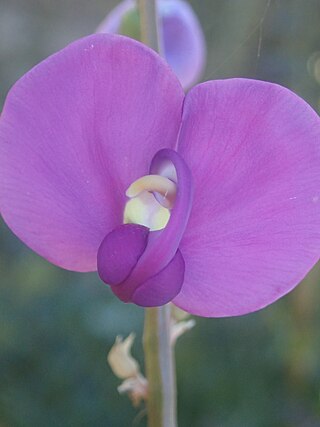
Swainsona procumbens is a plant in the pea family (Fabaceae) native to Australia and found in New South Wales, Victoria, Queensland and South Australia.

Bossiaea neoanglica is a species of flowering plant in the family Fabaceae and is endemic to eastern Australia. It is a prostrate to low-lying shrub with sparsely hairy foliage, egg-shaped to more or less round leaves, and yellow and red flowers.
Gompholobium polyzygum is a species of flowering plant in the family Fabaceae and is endemic to north-western Australia. It is an erect or prostrate shrub with pinnate leaves each with sixteen to twenty-one pairs of leaflets, and yellow-orange and greenish, pea-like flowers.

Swainsona maccullochiana, commonly known as Ashburton pea, is a species of flowering plant in the family Fabaceae. It is an upright annual with purple-reddish, pink or bluish pea-like flowers from spring to summer and is endemic to Western Australia.
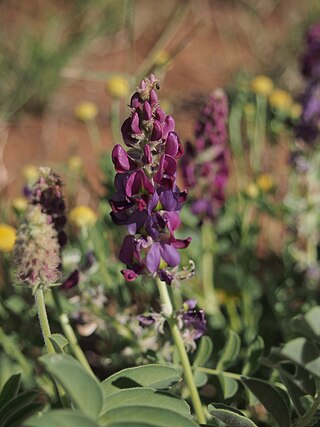
Swainsona canescens, commonly known as grey swainsona, is a flowering plant in the family Fabaceae. It is a small perennial herb with pink-purple or purple, yellow and green flowers and grows in Queensland, Western Australia and South Australia.
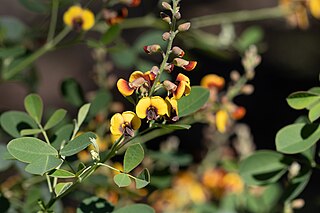
Goodia medicaginea, commonly known as western golden tip, is a species of flowering plant in the family Fabaceae and is endemic to southern continental Australia. It is a shrub with trifoliate leaves, the leaflets narrowly egg-shaped with the narrower end towards the base, and mostly yellow, pea-like flowers with red to purplish-black or brown markings.
Swainsona acuticarinata is a species of flowering plant in the family Fabaceae and is endemic to arid areas of central Australia. It is a prostrate perennial herb with imparipinnate leaves with 5 to 11 leaflets, and racemes of purple flowers.
Swainsona adenophylla, commonly known as violet swainson-pea or violet Darling pea, is a species of flowering plant in the family Fabaceae and is endemic to arid areas of central Australia. It is a slender, erect or spreading perennial herb with imparipinnate leaves with three to nine linear to narrowly egg-shaped leaflets, and racemes of pink or purplish flowers in racemes of ten to twenty.

Swainsona beasleyana is a species of flowering plant in the family Fabaceae and is endemic to inland areas of Western Australia. It is a low-lying perennial herb with imparipinnate leaves usually with 15 to 19 egg-shaped leaflets with the narrower end towards the base, and racemes of 3 to 8 pale or dark purple flowers.
Swainsona bracteata is a species of flowering plant in the family Fabaceae and is endemic to eastern Australia. It is a perennial herb with imparipinnate leaves usually with 19 to 25 narrowly egg-shaped leaflets, and racemes of about 20 white, pale pink or pale purple flowers.
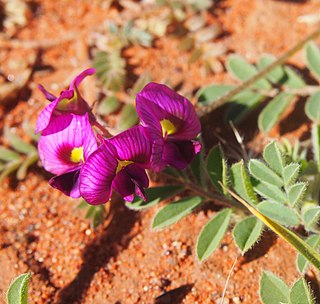
Swainsona burkei is a species of flowering plant in the family Fabaceae and is endemic to northern Australia. It is a prostrate or perennial subshrub with imparipinnate leaves usually with 5 to 11 oblong to narrowly egg-shaped leaflets, and racemes of 5 to 10 purple flowers.
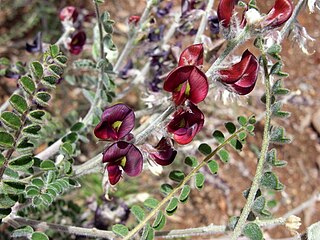
Swainsona burkittii, commonly known as woolly Darling pea, is a species of flowering plant in the family Fabaceae and is endemic to inland Australia. It is an erect or low-lying perennial with imparipinnate leaves usually with 15 to 30 egg-shaped to more or less circular leaflets, and racemes of up to fifty dark reddish-purple flowers.
Swainsona cadellii is a species of flowering plant in the family Fabaceae and is endemic to inland New South Wales. It is a shrubby perennial with imparipinnate leaves usually with 5 to 15 mostly narrowly egg-shaped leaflets, and racemes of 15 to 20 white, pink or purple flowers.
Swainsona calcicola is a species of flowering plant in the family Fabaceae and is endemic to north-western Western Australia. It is a prostrate or ascending, low-growing perennial with many stems, imparipinnate leaves usually with 7 to 11 broadly egg-shaped leaflets with the narrower end towards the base, and racemes of usually 4 or 5 pink, purple or red flowers.

Swainsona campestris is a species of flowering plant in the family Fabaceae and is endemic to arid areas of southern Australia. It is an erect perennial herb with imparipinnate leaves with 9 to 11 linear to narrowly lance-shaped leaflets, and racemes of pink or purple flowers in racemes of 5 to 10.
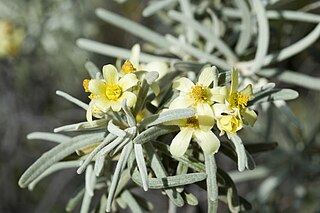
Ricinocarpos velutinus is a species of flowering plant in the family Euphorbiaceae and is endemic to the south-west of Western Australia. It is an erect, rounded, usually monoecious shrub with linear leaves, and yellow flowers with either all female or all male flowers, or one or two female flowers with up to 13 male flowers below them.

Swainsona campylantha, commonly known as Gilgai Darling pea, is a species of flowering plant in the family Fabaceae and is endemic to inland areas of Australia. It is a low-growing perennial with imparipinnate leaves usually with up to 7 narrowly lance-shaped to narrowly elliptic leaflets, and racemes of 2 to 10 pink to purple flowers.














